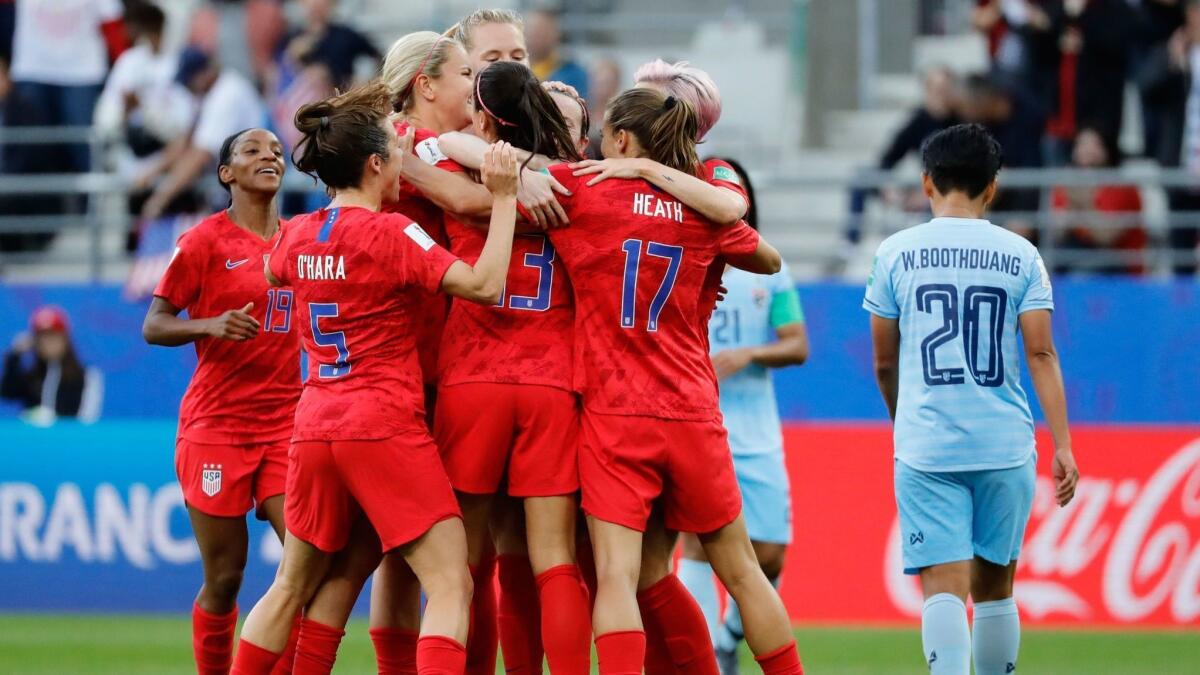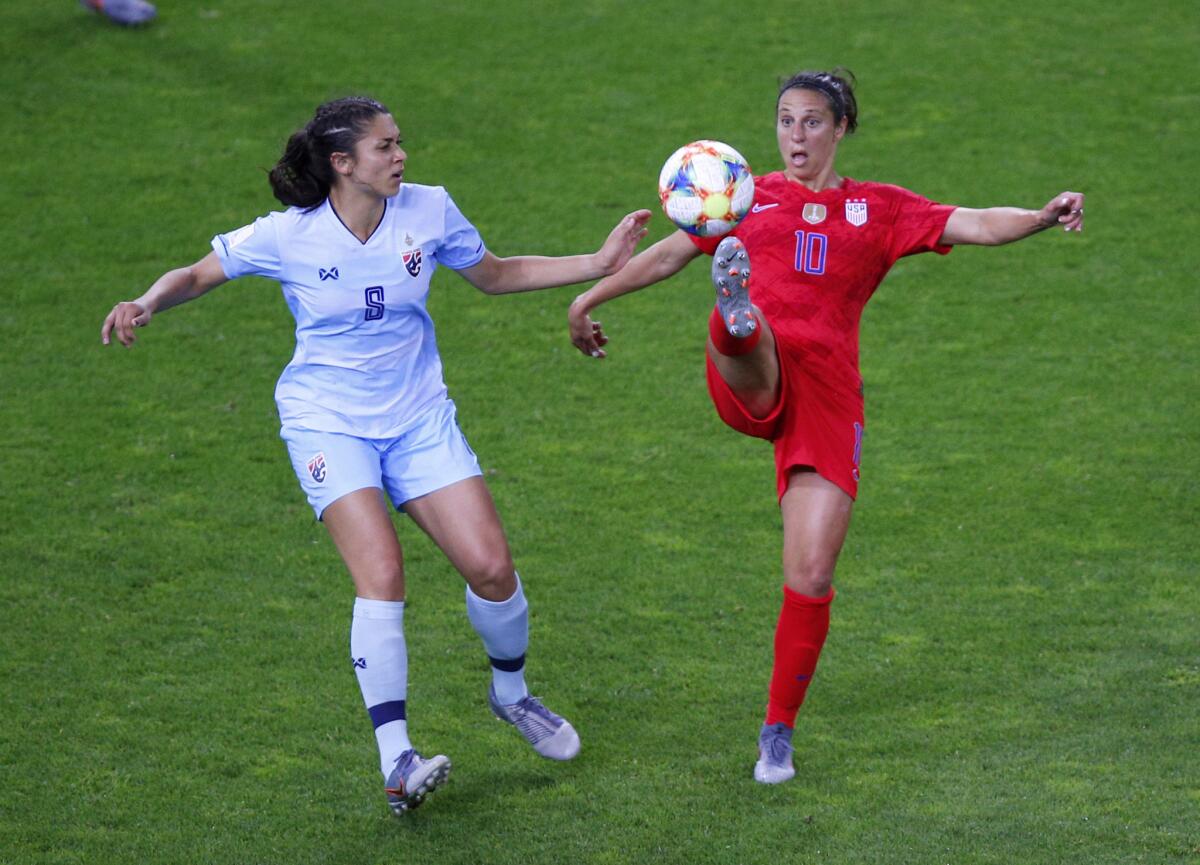Column: U.S. rout of Thailand proves that FIFA still has work to do to level the playing field

- Share via
Reporting from PARIS — The U.S. national team’s 13-0 shellacking of Thailand in its Women’s World Cup opener earlier this week revealed several truths.
It proved Alex Morgan, who had five goals and three assists, is not just really good but may be in the best form of her stellar career. It showed the Americans, in addition to their other talents, are really good at celebrating goals even when they come in the final minutes against an already humiliated opponent.
But most of all, it demonstrated that women’s soccer, for all its growth over the last four years, is still top heavy and has a lot of work to do to level its playing field.
Teams from the U.S., France, England, Germany and Japan all receive generous backing from their national federations, and their performances show it: All five are ranked among the top 10.
Thailand, Jamaica and Argentina? Not so much.
In many ways the rising tide of global support for women’s soccer has not raised all boats. Instead it has swamped, then capsized many of the smaller ones.
And it all comes down to money.
“Even a small amount of investment, the return is so great,” said former U.S. national team star Mia Hamm, who told a FIFA convention last week that continued progress in the women’s game is dependent on funding. “The impact it has on these players and their families and their communities going forward in terms of opportunities is huge.”
But in many places, that funding has been too little, too late or too undependable. So the women have begun forcing change themselves.
Jamaica’s national federation disbanded its women’s team in 2015 when the Reggae Girlz failed to qualify for the last World Cup. A year later, more than half of South America’s national soccer federations had their women’s programs listed as inactive by FIFA due to a lack of funding.
So Cedella Marley, the daughter of the late reggae star and soccer fan Bob Marley, stepped forward to fund the Jamaican team. In South America, it was the players themselves who demanded support. The Chileans formed a union, the National Assn. of Female Footballers, to petition for support. Argentina’s players went on strike in 2017 when the federation welshed on its promise to pay daily training stipends of $10.
The fact that Jamaica and Chile are participating in the World Cup this summer for the first time while Argentina — outscored 33-2 in its first two tournament appearances — played Japan to a draw in its opener here proves the obvious: Support makes a difference.
But how much is enough? And what’s the best way to get tight-fisted federations to open their wallets?
One idea was to hold out the carrot of a Women’s World Cup berth, which is why the tournament field has expanded twice since 1995, first from 12 to 16 teams and then to 24 teams four years ago. By making it possible for countries outside the traditional powers to at least participate in a global event, the thinking went, federations would begin supporting women’s soccer.
“The World Cup is as big for the smaller countries as it is for the bigger countries,” said Karina LeBlanc, a former Canadian international who heads the newly formed women’s soccer department for CONCACAF, the governing body for the sport in North America, Central America and the Caribbean.
“It’s important that we give these countries an opportunity. Whether they win or lose, it’s still impactful because they are there.”

And that’s worked — sort of. A record 155 countries now have active women’s programs. But it’s also resulted in some bad soccer. In 2015, Ivory Coast was pummeled by Germany 10-0 in its Women’s World Cup debut. And Ecuador was outscored 17-1 in its three group games in Canada.
But there have also been some successes. Spain finished last in its group in its first World Cup in 2015, but its participation helped spark interest in the sport back home. Clubs like Barcelona stepped up support of their women’s teams, Spain won the U-17 World Cup last year, and on Wednesday La Roja outplayed Germany, a two-time world champion, in a 1-0 loss.
Sign up for our weekly soccer newsletter »
“In the last three years, things have changed massively,” said Victoria Losada, midfielder for Spain. “Because of that World Cup … people now respect this sport.”
Which brings us back to Thailand and Tuesday’s 13-0 loss. The country never would have qualified for a World Cup had the field not expanded. Now it’s played in two.
“We’re a developing program. We all know that,” Thai forward Miranda Nild. “With this game under our belt, it will give us more knowledge going forward.”
It’s happened before. Eight years after the men’s World Cup field expanded to 32 teams, Ghana qualified for the first time. In its second tournament, it advanced to the quarterfinals.
“Money is key,” LeBlanc said. “FIFA is giving each member association the opportunity to grow the women’s game by having access to more funds for just the women’s side. We’re doing the same.”
CONCACAF has already invested in development programs and staged six competitions involving nearly 2,000 female athletes across the region. And last week it expanded that commitment, announcing a strategic plan to communicate the importance of women’s soccer, advocate on key issues and build a self-sustaining growth model to enhance the game’s commercial value.
For the federations, LeBlanc said, funding women’s programs should be seen as “an opportunity rather than a cost.”
“When they start seeing that and the power of the women’s game,” she said, “that’s when the conversation stops being all about money and it starts being about the power of the game.”
If that happens, the next time the U.S. plays Thailand, maybe we’ll be talking about the game and not the goal celebrations.
[email protected] | Twitter: @kbaxter11







